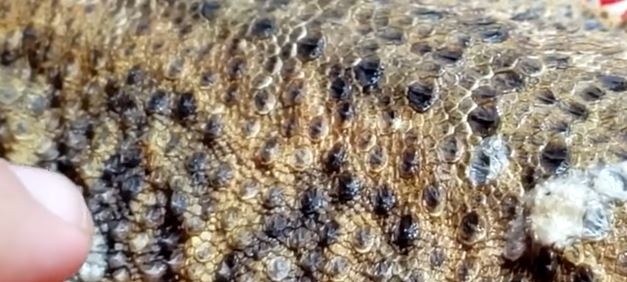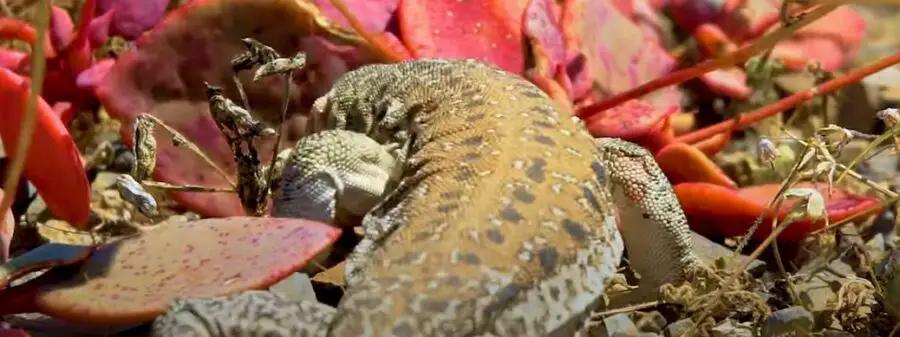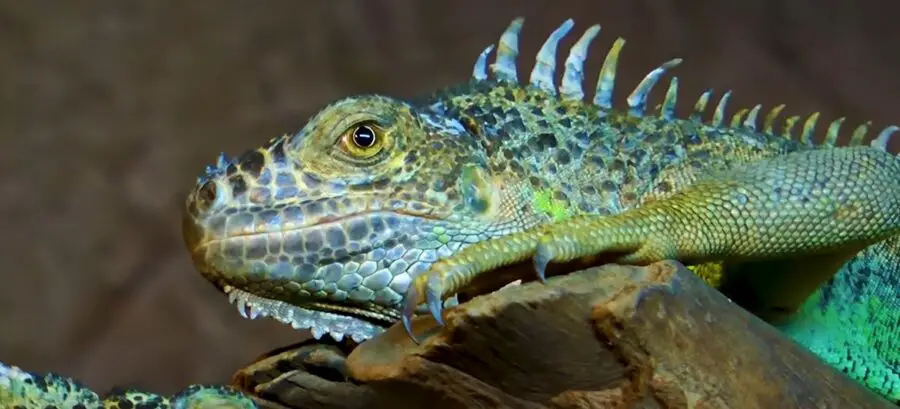When I noticed new spots on my iguana, I immediately started to worry. I asked around and searched about why does my iguana have black, brown, white, yellow spots on them?
The answers I received from experienced members of the reptile community and the vet are interesting to say the least.
Allow me to explain what I found out about color spots on iguanas in this article.
Why Does My Iguana Have Black, Brown, White, Yellow Spots on Them?
Since iguanas do not vocally communicate their distress or changes through their life cycle in other ways, these spots can give you a clue as to what’s going on with your reptile companion.
Unfortunately, many color spots indicate poor health or negative reactions to external stimuli such as:
- Fungal infections
- Bacterial growth
- Trauma
- Burns
- Overheating
- Parasites
- Mites
- Shedding
Changes in color due to maturity are often coupled with shedding phases. These spots are more common and should not be a cause for concern.
Some iguanas are naturally spotted, dotted and striped. For a breakdown of each color spot, please check out the research below.

Spots on Green Iguana
Your green iguana may be getting darker. They are born bright green, but develop changes in color to slightly darken their skin in about 1 year.
Their belly will remain the most green and brightest area, but the rest of their body starts to darken, it doesn’t happen all at once. This new coloration will see your green iguana shifting or darkening with spots and stripes.
You may notice spots that are:
- Brown
- Orange
- Black
- Red
- Blue
Green iguanas will experience fading of colors as they age as well. Random spots can also be due to:
- burns
- wounds
- infections
- parasites
If your iguana is not eating, lethargic, experiences abnormal defecation or the spots look worse, they are a warning sign to see the vet about possible medical treatments.
Why Does My Iguana Have Black Spots?
Black spots are usually a sign for concern. There may have been an accident or an infestation that occurred in their enclosure or elsewhere.
The sad news is that it is usually associated to the following:
- Bacterial infection
- Mites
- Burns
- Fungal infection
The good news is that if you notice these spots going away, this is part of their normal coloration. Spots, dots, lines and stripes are normal as your iguana is maturing.
If this is an infection that is fungal or bacterial, the overall look will be unsightly with missing scales or skin rot.

How To Treat Black Spots On Iguana
You will need a diagnosis and a possible visit to the vet to figure out why your iguana has black spots. Treatment varies with the following being this most notable:
- Anti-fungal cream (Nizoral or Terbinafine)
- Lower humidity to 60%
- Increased ventilation in the enclosure
- Remove loose substrate
- Bathe to help with shedding
- Soaking with Betadine and water (1:100 solution)
The methods outlined above only work well when you know that your iguanas black spots are not caused from bruising, burns or natural coloration.
Monitor the spots to see if they worsen, spread. They may cause erosion of scales or shift your iguanas overall health into a poor condition where they don’t eat or move around much.
Temperature could also be an issue that may cause death. Double check that in this article I wrote.
Iguana Bacterial Infection
A bacterial infection in an iguana will be more than just noticeable spots. They will also be coupled with discomforting:
- Dry skin
- Crusty scales
- Bumps
- Abnormal peeling
- Flaking
A swab test is usually undertaken at a vet’s clinic to determine if the infection is bacterial. Many over-the- counter anti-fungal creams like Betadine are also helpful to prevent the spread of bacteria.
Bacterial infections may have arrived from unsanitary conditions before you brought your new pet home.
Treat Infections On Iguanas
Iguana may develop external infections that look like spots on their bodies. Treatment is varied, but there are some practices that should be followed such as:
- Cage cleaning each week
- Stress-free environment (reduce volume, reduce high traffic around enclosure)
- Regular feedings of staple food (leafy greens, etc.)
- Adequate UVB lighting, humidity
- Increase supplements
- Antifungal or antibacterial ointment
With treatment comes improvement to their skin that is noticeable. Your effort goes a long way to save a dying iguana. See more on that here.
If your iguana’s skin begins to return to normal, or is experiencing normal coloration that is slightly changing their overall tone, this is common and will require no further treatment.

Red Spots On Iguana
Iguana Mites or ticks
Sometimes the red, black or brown spots on an iguana come from bites from mites or ticks, Sometimes they are not spots at all and the parasites are still on their body. These spots are not actually spots. They are the mites or ticks themselves!
Mites and ticks cause:
- Skin peeling
- Skin darkening
- Infections
- Illness/death
If you notice your iguana is constantly rubbing against surfaces, they are uncomfortable. The skin may be infected with these parasites and medical attention is needed before it’s too late.
Treatment of Mites and Ticks On Iguana
Mites and ticks can hide really well in enclosures and under the scales of an iguana. The skin may look red, brown or black spots or wounds. Here are some treatment options for you to consider:
- Relocate your iguana into a large container.
- Remove all items from their enclosure.
- Throw some items away and bake others in an oven for 45 minutes at 230°F to kill parasites.
- Wash anything else with bleach and water at (1:20 solution).
- Use mite/tick spray in the enclosure after a thorough cleaning.
- Inspect your iguana for ticks and begin removing them one at a time.
- Use a tick removal tool or tweezers.
Why Does My Iguana Have Brown Spots?
Brown spots could be due to mites, ticks, infections, but more often than not it’s normal coloration patterns while your iguana is maturing. If the spots are coupled with dots, lines and stripes that are brown, there should be no cause for concern.
Sometimes the brown spots are noticeable burns instead. Burns are common when iguanas get too close to heat lamps when they are basking.
Burns spots can also look like
- Yellow spots
- Blue spots
As these burns recover the spots can look
- Gray
- White
- Black
How To Reduce Brown Spots On Iguanas
- Make sure the lightning in the tank doesn’t contain very hot bulbs that are uncovered and unprotected.
- Do not use hot rocks near the bulbs as they can absorb heat and also burn your reptile companion.
- Keep lighting 10-12 inches away in a spot where direct contact is not possible.
- Treat burns with burn cream and antiseptic without alcohol or oils.
- Keep the wound clean with saline solution.
You may use human grade burn creams. Otherwise visit the exotic pet store or vet clinic for a product intended for reptiles.
Either way, address the reason why they got burned to prevent it from happening in the future.

Why Does My Iguana Have White Spots?
White spots on an iguana are usually due to:
- shedding
- excess salt
When an iguana sheds, this happens in patches. These areas look like spots sometimes. The color is off-white, creamy or milky.
When you help your iguanas with misting or bathing, these patches are removed naturally and more easily. Every 4-6 weeks, you will notice these whitish spots developing and this is quite normal.
This phase is prolonged and does not reoccur as often in the winter. White spots around the enclosure could be from the excess salt out of your iguana’s nose when they sneeze.
Some of this excess salt could be noticed around their face as well. While they look like spots, they are actually just salt stains that can be removed.
Iguana with Yellow Spots
Yellow spots could be due to shedding as well, but there is a more serious concern when it’s the spread of Salmonellosis. This infection may create yellow or orange spots on your iguana.
The Salmonella bacteria could be thriving and spreading on the skin of your iguana. This is usually due to them arriving with the bacteria from poor breeding or captive conditions.
Otherwise the enclosure they live in now is also infected with this bacteria. Treatment requires antibiotic creams or injections. If your iguana is not moving, check this article as well which could help.
You will have to visit the vet if these yellow spots persist. You will also receive recommendations to adjust lighting, humidity and add supplements to your iguana’s diet.
What is The Circle on an Iguana?
The circle you see on the cheeks of iguana or around their jowl is known as the subtympanic shield. This is a normal circle spot and it is sometimes referred to as a helmet scale.
There is no scientific evidence to prove why they have this circle or button on their jowl, but it could be due to:
- Breaking up their outline in the trees (camouflage).
- A fake eyespot to scare or startle other creatures.
- Increased mobility of the jowl.
The subtympanic shield is not an abnormal spot or growth and it is found on many species of iguanas in captivity and in the wild.
Thank you for visiting PocketPetCentral.com for the best information to help you enjoy the life of your pocket pet companion in a fun, safe & healthy way.

